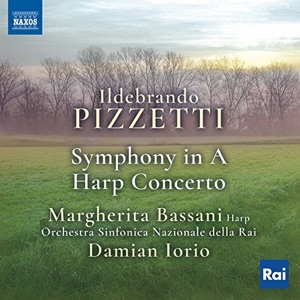Pizzetti’s Symphony in A dates from 1940. It’s a substantial work, forty-three minutes long in this performance, with beautiful moments–especially those employing modal harmony. That said, the piece is almost completely tensionless. Yes, the finale contains some strident march episodes, and there’s a swift scherzo, but the general impression remains one of sustained gentleness. I can’t help but wonder if a more emphatic interpretation might change this perception, but the performance as such sounds comfortably idiomatic, and any lack of character in the music surely stems from the composer.
The Harp Concerto is very pretty, as most harp concertos invariably are, but again the music tends to meander rather than flow. Certainly soloist Margherita Bassani plays well, and Damian Iorio accompanies like a pro, but the work contains almost no quick music at all. The result, even though it lasts only a bit more than twenty minutes, tends to sound much longer. The sonics are good, and it’s nice to have this rare repertoire on disc, but it’s not a terribly urgent acquisition.
































